

A pediatric dentist is a dental professional who specializes in providing oral healthcare for children, infants, adolescents, and individuals with special needs. They have extensive training beyond dental school to learn how to best care for the unique dental needs of children. They focus on preventive care and education to help children develop good oral hygiene habits and maintain healthy teeth and gums for life.
Primary teeth, also known as baby teeth, are important for several reasons. They help children chew and speak properly, and they also play a crucial role in the development of permanent teeth. Baby teeth act as placeholders for the permanent teeth, helping to guide them into their proper positions in the mouth. In addition, healthy primary teeth can help children develop good oral hygiene habits that will last a lifetime.
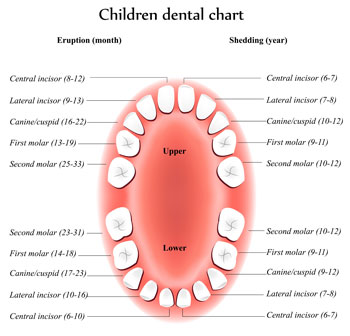 The eruption of a child’s teeth is a natural and important part of their development. Primary teeth, also known as baby teeth, typically begin to emerge around six to twelve months of age, and there are a total of 20 primary teeth. These include 8 incisors, 4 canines, and 8 molars.
The eruption of a child’s teeth is a natural and important part of their development. Primary teeth, also known as baby teeth, typically begin to emerge around six to twelve months of age, and there are a total of 20 primary teeth. These include 8 incisors, 4 canines, and 8 molars.
Permanent teeth, on the other hand, typically begin to emerge around six years of age and continue to come in until the late teens or early twenties. There are a total of 32 permanent teeth, including 8 incisors, 4 canines, 8 premolars, and 12 molars.
 At Washington Pediatric Dentistry in Silver Spring, MD, we understand that dental emergencies can happen at any time. If your child experiences any of the following dental emergencies, please follow the steps outlined below:
At Washington Pediatric Dentistry in Silver Spring, MD, we understand that dental emergencies can happen at any time. If your child experiences any of the following dental emergencies, please follow the steps outlined below:
Toothache: In case of a dental emergency toothache in a child, clean the affected area, rinse with warm water, and use dental floss to dislodge any food. Contact your child’s dentist immediately if the pain persists, and do not apply aspirin or heat to the gum or tooth.
Cut or Bitten Tongue, Lip, Cheek: Apply ice to the injured area to control swelling and apply firm but gentle pressure with a gauze or cloth to stop bleeding. Seek medical attention if bleeding cannot be controlled.
Knocked-Out Permanent Tooth: In case of a dental emergency involving a knocked-out permanent tooth, try to find the tooth, rinse it with water only, and try to reinsert it into the socket. If that is impossible, transport the tooth in a cup of the patient’s saliva or milk and seek dental attention immediately.
Knocked-Out Baby Tooth: In case of a dental emergency involving a knocked-out baby tooth, contact your pediatric dentist and do not attempt to replant the tooth. In most cases, no treatment is necessary.
Chipped/Fractured Permanent Tooth: Contact your pediatric dentist immediately and rinse the mouth with water. Apply a cold compress to reduce swelling, and bring any broken tooth pieces with you to the dentist.
Chipped/Fractured Baby Tooth: A chipped or fractured baby tooth can be a cause for concern for parents, especially if the tooth is causing discomfort or pain for their child. If a baby tooth is chipped or fractured, it’s important to contact a pediatric dentist for treatment.
Possible Broken or Fractured Jaw: If you suspect your child has a broken or fractured jaw, it’s important to keep the jaw from moving and take them to the nearest hospital emergency room immediately.
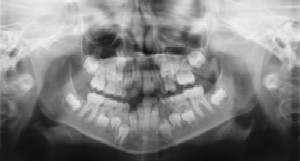 Dental radiographs, also known as X-rays, are an important diagnostic tool in pediatric dentistry. They allow pediatric dentists to see areas of the teeth and jaw that are not visible during a regular dental exam. This includes areas between the teeth, below the gum line, and inside the jawbone.
Dental radiographs, also known as X-rays, are an important diagnostic tool in pediatric dentistry. They allow pediatric dentists to see areas of the teeth and jaw that are not visible during a regular dental exam. This includes areas between the teeth, below the gum line, and inside the jawbone.
Radiographs can help identify dental problems that may not be visible to the naked eye, such as tooth decay, impacted teeth, and jaw or bone structure abnormalities. They can also help monitor the development of permanent teeth and detect any potential issues early on.
By identifying dental problems early, pediatric dentists can provide prompt treatment to prevent more serious problems from developing. Overall, dental radiographs are a safe and important tool in pediatric dentistry, and they play a crucial role in maintaining children’s oral health.
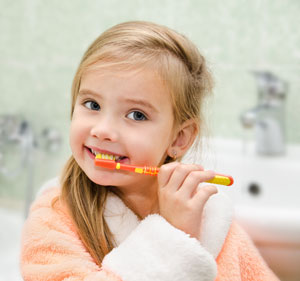 When choosing a toothpaste for your child, it’s important to look for the American Dental Association (ADA) seal of approval, which indicates that the toothpaste has been tested and found to be safe and effective. You should also consider your child’s specific dental needs, such as sensitivity or cavity-prone teeth, and consult with your pediatric dentist for personalized recommendations.
When choosing a toothpaste for your child, it’s important to look for the American Dental Association (ADA) seal of approval, which indicates that the toothpaste has been tested and found to be safe and effective. You should also consider your child’s specific dental needs, such as sensitivity or cavity-prone teeth, and consult with your pediatric dentist for personalized recommendations.
For infants and toddlers (under 2 years old), using a fluoride-free toothpaste specifically designed for their age group is recommended, as fluoride can be harmful if ingested in large amounts. For children over 2 years old, toothpaste that contains fluoride is recommended, as it helps strengthen tooth enamel and prevent tooth decay.
 Thumb sucking is a common habit among young children that provides comfort and security. However, prolonged thumb sucking can lead to dental problems, including the misalignment of the teeth and changes to the shape of the mouth and jaw.
Thumb sucking is a common habit among young children that provides comfort and security. However, prolonged thumb sucking can lead to dental problems, including the misalignment of the teeth and changes to the shape of the mouth and jaw.
Parents can try several strategies to help break the habit of thumb-sucking. Positive reinforcement can be effective, such as praising the child for not sucking their thumb. Providing distractions, such as a toy or game, can also help redirect the child’s attention away from thumb-sucking. In some cases, a pediatric dentist may recommend a mouthguard or thumb-sucking appliance to help discourage the habit.
If the habit of thumb sucking persists and is affecting the child’s dental health, a pediatric dentist can provide further guidance and treatment options. By addressing thumb-sucking early on, parents can help prevent future dental problems and promote good oral health for their children.
Pulp therapy is a dental treatment that is performed to save a tooth that has been affected by decay or injury that has reached the pulp, which is the innermost part of the tooth. The pulp contains nerves, blood vessels, and connective tissue that help the tooth grow and develop.
Pulp therapy involves removing the affected pulp tissue, cleaning and disinfecting the area, and then filling the space with a biocompatible material to help support the remaining tooth structure. In some cases, a crown may be placed over the tooth to help provide additional support and protection.
Pulp therapy is commonly performed on baby teeth, as they play a crucial role in guiding the development of adult teeth. However, it can also be performed on adult teeth in some cases.
By performing pulp therapy, dentists can help save damaged teeth and prevent the need for more extensive treatments such as tooth extraction. If you suspect that your child has a dental problem that may require pulp therapy, it’s important to consult with a pediatric dentist for an evaluation and personalized treatment recommendations.
 The best time for orthodontic treatment depends on each individual’s specific dental needs and development. In general, orthodontic treatment is most effective when it is performed during childhood or early adolescence, as this is when the teeth and jaw are still developing and can be more easily guided into the desired position.
The best time for orthodontic treatment depends on each individual’s specific dental needs and development. In general, orthodontic treatment is most effective when it is performed during childhood or early adolescence, as this is when the teeth and jaw are still developing and can be more easily guided into the desired position.
The American Association of Orthodontists recommends that children have their first orthodontic evaluation by age 7. At this age, the dentist can identify any potential orthodontic problems and determine if early intervention is necessary. Early orthodontic treatment can help prevent more serious problems from developing and may also reduce the need for more extensive treatment in the future.
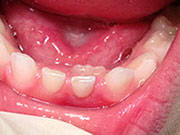 Adult teeth coming in behind baby teeth is a dental problem that can occur in some children. This happens when the permanent teeth start to grow while the baby teeth are still in place and can cause the permanent teeth to come in at an incorrect angle or position.
Adult teeth coming in behind baby teeth is a dental problem that can occur in some children. This happens when the permanent teeth start to grow while the baby teeth are still in place and can cause the permanent teeth to come in at an incorrect angle or position.
If you notice that your child’s permanent teeth are coming in behind their baby teeth, it’s important to schedule an appointment with a pediatric dentist. The dentist can evaluate your child’s teeth and determine the best course of treatment.
 Perinatal and infant oral health is an important aspect of overall health for both mother and baby. Good oral health during pregnancy can reduce the risk of pregnancy complications and ensure a healthy start for the baby.
Perinatal and infant oral health is an important aspect of overall health for both mother and baby. Good oral health during pregnancy can reduce the risk of pregnancy complications and ensure a healthy start for the baby.
After birth, proper oral care for the infant can help prevent early childhood cavities and promote good oral health for life. Working closely with your healthcare provider and pediatric dentist is important to ensure optimal oral health for both mother and baby.
Here are some tips for maintaining good perinatal and infant oral health:
Establishing a dental home is important in promoting good oral health for your child. The American Academy of Pediatric Dentistry recommends that children visit a pediatric dentist by their first birthday or within six months of the first tooth eruption. This first dental visit is an opportunity to establish a relationship with a dental provider and receive important education and guidance on oral care for your child.
During the first dental visit, the dentist will examine your child’s teeth and gums and provide recommendations for oral care. They will also discuss important topics such as fluoride, nutrition, and the prevention of dental decay. This first visit is a chance to address any concerns you may have and establish a plan for ongoing oral care for your child.
 Baby bottle tooth decay, also known as early childhood caries, is a common condition that affects young children. It is caused by frequent and prolonged exposure of a child’s teeth to sugary liquids such as milk, formula, and fruit juice. The bacteria in the mouth feed on the sugars and produce acid, which can erode the tooth enamel and lead to cavities.
Baby bottle tooth decay, also known as early childhood caries, is a common condition that affects young children. It is caused by frequent and prolonged exposure of a child’s teeth to sugary liquids such as milk, formula, and fruit juice. The bacteria in the mouth feed on the sugars and produce acid, which can erode the tooth enamel and lead to cavities.
To prevent baby bottle tooth decay, it’s important to avoid giving your child sugary drinks before bedtime or during prolonged periods of the day. Instead, offer water or a pacifier. It’s also important to avoid dipping pacifiers in sugar or honey. Practice good oral hygiene habits with your child, including brushing twice daily with a smear of fluoride toothpaste and wiping their gums with a clean, damp cloth after feedings.
If you suspect your child may have baby bottle tooth decay, it’s important to schedule a dental visit as soon as possible.
Sippy cups can contribute to tooth decay if used improperly. To prevent oral health issues, limit their use and encourage your child to use a regular cup as soon as possible. Choose a sippy cup with a soft spout, avoid using sugary liquids, and clean it regularly to prevent bacterial growth.
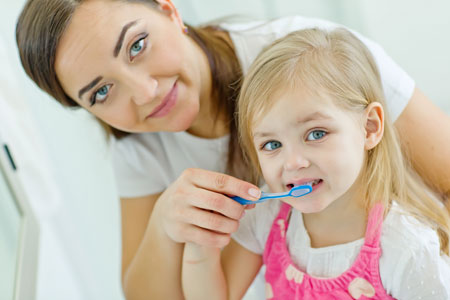 Brushing Tips:
Brushing Tips:Preventing cavities in toddlers and children is crucial for maintaining good oral health. Establishing good oral hygiene habits is the first step in cavity prevention, including regular brushing and flossing with fluoride toothpaste. Encouraging a healthy, balanced diet and limiting sugary and acidic foods and drinks can also help prevent cavities. Drinking plenty of water can help wash away food particles and bacteria and keep the mouth hydrated.
In addition to good oral hygiene habits and a healthy diet, regular dental checkups and cleanings are important for preventing cavities and other dental problems. Your pediatric dentist can detect and treat cavities early and recommend dental sealants to protect your child’s teeth from decay.
By following these tips and working closely with your pediatric dentist, you can help prevent cavities in toddlers and children and promote good oral health for life.
Dental sealants are thin coatings applied to the chewing surfaces of back teeth to prevent tooth decay. They work by filling in deep grooves and pits, making the surface easier to clean and less likely to trap bacteria and food particles.
Sealants can last for years and are checked during regular dental checkups. Using sealants as a preventative measure can help protect teeth from decay and promote good oral health.
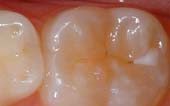
Before Sealant Applied
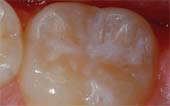
After Sealant Applied
Fluoride is important for maintaining good oral health in toddlers and children. It helps to strengthen tooth enamel, making teeth more resistant to decay.
It’s important to ensure your child gets the right amount of fluoride. Too little fluoride may not provide enough protection against decay. At the same time, too much fluoride can lead to dental fluorosis, which causes white spots or streaks on the teeth.
The American Dental Association recommends that children under three years old use a smear of fluoride toothpaste (about the size of a grain of rice) when brushing their teeth. Children between the ages of three and six should use a pea-sized amount of fluoride toothpaste.
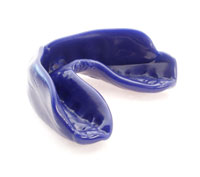 Mouth guards protect children’s teeth and jaws during physical activities and sports. Custom-fitted mouth guards made by a dentist provide the best fit and protection, but boil-and-bite mouth guards can be purchased at sporting goods stores.
Mouth guards protect children’s teeth and jaws during physical activities and sports. Custom-fitted mouth guards made by a dentist provide the best fit and protection, but boil-and-bite mouth guards can be purchased at sporting goods stores.
A well-fitted mouth guard should not interfere with breathing or speaking and should be worn during any activity that poses a risk of oral injury. Using a properly fitted mouth guard can help protect your child’s teeth and promote good oral health.
Xylitol is a natural sugar substitute that can help reduce cavities in children and adults. It works by inhibiting the growth of cavity-causing bacteria in the mouth, preventing them from producing harmful acids that erode tooth enamel.
Xylitol is found in many sugar-free gums, candies, and oral care products. It can be used as a natural sweetener in cooking and baking. Incorporating xylitol into your child’s diet and oral care routine can help reduce the risk of cavities and promote good oral health.
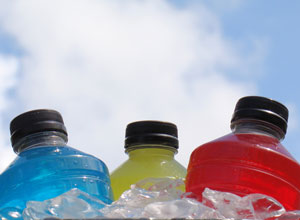 Sports drinks are popular among children and teenagers but can pose hidden dangers to oral health. These drinks are often high in sugar and acid, eroding tooth enamel and increasing the risk of cavities.
Sports drinks are popular among children and teenagers but can pose hidden dangers to oral health. These drinks are often high in sugar and acid, eroding tooth enamel and increasing the risk of cavities.
In addition, frequent consumption of sports drinks can lead to tooth sensitivity and discoloration. It’s important to encourage your child to drink water instead of sports drinks and to limit their consumption of sugary and acidic foods and drinks for good oral health.
Here are some tips for consuming sports drinks in a way that minimizes the risk to oral health:
Adolescent dentistry is a specialized area of dental care that focuses on the oral health needs of teenagers. It is a crucial time in a child’s life as they transition into adulthood and make important decisions that can impact their health for years to come. As part of adolescent dentistry, dentists address issues such as cavities, gum disease, and orthodontic needs.
Nowadays, tongue piercing is a popular form of self-expression among teenagers. However, it can pose serious risks to oral health. The piercing can lead to infections, swelling, and damage to teeth and gums. In addition, metal jewelry can cause abrasions to the mouth’s soft tissues. Parents need to talk to their teenagers about the risks of tongue piercing and encourage them to choose safer forms of self-expression.
Tobacco use is another major concern in adolescent dentistry. Smoking and using smokeless tobacco can cause many oral health problems, including gum disease, tooth decay, and oral cancer. Parents and dentists need to educate teenagers about the dangers of tobacco use and encourage them to make healthy choices that promote good oral and overall health.